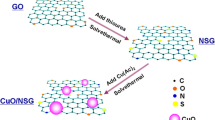Abstract
The graphene/carbon nanotube hybrid was designed and implemented by a deoxygenation process for direct electron transfer of glucose oxidase and glucose biosensor. The procedure was analyzed by transmission electron microscopy, X-ray photoelectron spectroscopy, and Raman spectra, etc. The strategy of structurally engineering one-dimensional carbon nanotube (CNT) and two-dimensional graphene oxide (GO) presented three benefits: (a) a deoxygenation process between GO and acid-CNT was introduced under strongly alkaline condition; (b) GO prevented the irreversible integration of CNT; and (c) CNT hindered the restacking of GO. The RGO interacted with CNT through the van der Waals forces and π–π stacking interaction. The three-dimensional hybrid not only had a high surface area, but also exhibited a good electronic conductivity. A direct electrochemistry of glucose oxidase was obtained on the nanohybrid modified electrode which showed good response for glucose sensing. This study would provide a facile and green method for the preparation of nanohybrid for a wide range of applications including biosensing, super capacitor, and transparent electrode.










Similar content being viewed by others
References
Liu Q, Lu X, Li J, Yao X, Li J (2007) Biosens Bioelectron 22:3203. doi:10.1016/j.bios.2007.02.013
Kang X, Wang J, Wu H, Aksay IA, Liu J, Lin Y (2009) Biosens Bioelectron 25:901. doi:10.1016/j.bios.2009.09.004
Wang L, Wang E (2004) Electrochem Commun 6:49. doi:10.1016/j.elecom.2003.10.004
Guo CX, Li CM (2010) Phys Chem Chem Phy 12:12153. doi:10.1039/c0cp00378f
Krajewska B (2004) Enzyme Microb Technol 35:126. doi:10.1016/j.enzmictec.2003.12.013
Liu Y, Wang M, Zhao F, Xu Z, Dong S (2005) Biosens Bioelectron 21:984. doi:10.1016/j.bios.2005.03.003
Cai C (2004) Anal Biochem 332:75. doi:10.1016/j.ab.2004.05.057
Wu P, Shao Q, Hu Y et al (2010) Electrochim Acta 55:8606. doi:10.1016/j.electacta.2010.07.079
Pingarron J, Yanezsedeno P, Gonzalezcortes A (2008) Electrochim Acta 53:5848. doi:10.1016/j.electacta.2008.03.005
Bao S-J, Li C-M, Zang J-F, Cui X-Q, Qiao Y, Guo J (2008) Adv Funct Mater 18:591. doi:10.1002/adfm.200700728
Rivas G, Rubianes M, Rodriguez M (2007) Talanta 74:291. doi:10.1016/j.talanta.2007.10.013
Gao Q, Guo Y, Zhang W, Qi H, Zhang C (2011) Sens Actuat B Chem 153:219. doi:10.1016/j.snb.2010.10.034
Akhavan O, Ghaderi E, Rahighi R (2012) ACS Nano 6:2904. doi:10.1021/nn300261t
Gutés A, Carraro C, Maboudian R (2012) Biosens Bioelectron 33:56. doi:10.1016/j.bios.2011.12.018
Pumera M, Ambrosi A, Bonanni A, Chng ELK, Poh HL (2010) Trends Anal Chem 29:954. doi:10.1016/j.trac.2010.05.011
Qian Y, Lu S, Gao F (2011) J Mater Sci 46:3517. doi:10.1007/s10853-011-5260-y
Yu D, Dai L (2010) J Phys Chem Lett 1:467. doi:10.1021/jz9003137
Yang SY, Chang KH, Tien HW et al (2011) J Mater Chem 21:2374. doi:10.1039/c0jm03199b
Yang W, Ratinac KR, Ringer SP, Thordarson P, Gooding JJ, Braet F (2010) Angew Chem Int Ed 49:2114. doi:10.1002/anie.200903463
Lee CH, Yang CK, Lin MF, Chang CP, Su WS (2011) Phys Chem Chem Phy 13:3925. doi:10.1039/c0cp01569e
Byon HR, Lee SW, Chen S, Hammond PT, Shao-Horn Y (2011) Carbon 49:457. doi:10.1016/j.carbon.2010.09.042
Das S, Seelaboyina R, Verma V et al (2011) J Mater Chem 21:7289. doi:10.1039/c1jm10316d
Yu K, Lu G, Bo Z, Mao S, Chen J (2011) J Phys Chem Lett 2:1556. doi:10.1021/jz200641c
Hong T-K, Lee DW, Choi HJ, Shin HS, Kim B-S (2010) ACS Nano 4:8
Shao G, Lu Y, Wu F, Yang C, Zeng F, Wu Q (2012) J Mater Sci 47:4400. doi:10.1007/s10853-012-6294-5
Zhang C, Ren L, Wang X, Liu T (2010) J Phys Chem C 114:11435
Fan X, Peng W, Li Y et al (2008) Adv Mater 20:4490. doi:10.1002/adma.200801306
Yang D, Velamakanni A, Bozoklu G et al (2009) Carbon 47:145. doi:10.1016/j.carbon.2008.09.045
Lee V, Whittaker L, Jaye C, Baroudi KM, Fischer DA, Banerjee S (2009) Chem Mater 21:3905. doi:10.1021/cm901554p
Alwarappan S, Liu C, Kumar A, Li C-Z (2010) J Phys Chem C 114:12920. doi:10.1021/jp103273z
Stankovich S, Dikin DA, Piner RD et al (2007) Carbon 45:1558. doi:10.1016/j.carbon.2007.02.034
Eda G, Chhowalla M (2010) Adv Mater 22:2392. doi:10.1002/adma.200903689
Wanekaya AK, Chen W, Myung NV, Mulchandani A (2006) Electroanalysis 18:533. doi:10.1002/elan.200503449
Unnikrishnan B, Palanisamy S, Chen SM (2012) Biosens Bioelectron. doi:10.1016/j.bios.2012.06.045
Acknowledgments
This work was financially supported by the National Natural Science Foundation of China (Nos. 21075051, 21143008 and 50832001), Program for New Century Excellent Talents in University (NCET-10-0433), the “211” and “985” project of Jilin University, China, and State Key Laboratory of Electroanalytical Chemistry, CIAC, CAS.
Author information
Authors and Affiliations
Corresponding authors
Rights and permissions
About this article
Cite this article
Chen, J., Zheng, X., Miao, F. et al. Engineering graphene/carbon nanotube hybrid for direct electron transfer of glucose oxidase and glucose biosensor. J Appl Electrochem 42, 875–881 (2012). https://doi.org/10.1007/s10800-012-0461-x
Received:
Accepted:
Published:
Issue Date:
DOI: https://doi.org/10.1007/s10800-012-0461-x




